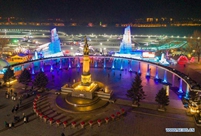

BEIJING, Jan. 13 (Xinhua) -- Millions of Chinese are travelling smarter, faster, more efficiently and more comfortably than ever before after one of the world's largest human migrations got underway last Friday.
And the travel choices for the 2020 Spring Festival travel rush are also more diverse with a comprehensive transport system covering road, rail, water and air.
The travel rush, which sees families and friends reunite around the country for China's most important traditional holiday, began 15 days ahead of the Spring Festival, or Chinese Lunar New Year, which falls on Jan. 25 this year.
The high-speed rail link between Beijing and Zhangjiakou, co-host city of the Beijing 2022 Winter Olympics in north China's Hebei Province, started operating on Dec. 30 last year.
The travel time between the two cities has been greatly shortened, and Zhangjiakou is now with Beijing's one-hour economic circle, said Li Shengwu, head of the Infrastructure Development Department of Zhangjiakou Development and Reform Commission.
A core part of the "eight verticals and eight horizontals" rail network, the Beijing-Zhangjiakou high-speed service connects with the Zhangjiakou-Hohhot and Datong-Zhangjiakou high-speed lines, helping to reduce the holiday travel pressure in Beijing, eastern Inner Mongolia, Shanxi Province and northern Hebei Province.
Travel is becoming more efficient for travelers this Spring Festival, who are expected to make 3.6 billion trips during the period.
Ticket sale is the first big test. Rapid technological development has accelerated online ticket sales and ticket checking.
In the 2020 holiday rush, the daily ticketing capacity of the official 12306 online booking service will increase from 15 million to 20 million.
Ticket checking is faster as e-tickets are quickly replacing paper tickets. The checking of e-tickets, a service now available at all high-speed railway stations, takes 30 percent less time compared with manual checking of paper tickets.
Facial recognition technology has also been used in some stations to speed up the ticket checking process.
Travel services are also becoming more intelligent with robot information services and intelligent storage facilities further improving travel efficiency.
In recent years, stations with heavy traffic such as the southern city of Guangzhou and the northwestern city of Xi'an have been using patrol robots for security. The robot can be on duty 24 hours a day in all weathers and check potential risks to prevent fire and other safety problems.
Artificial intelligence (AI) security monitoring is realizing real-time analysis and early warning of passenger flows, so authorities can effectively prevent stampedes and other safety issues during the travel rush.
The Beijing-Zhangjiakou railway is the first intelligent high-speed service with scientific and technological elements inside and out.
The carriages offer 5G signal, wireless charging, intelligent light adjustment, stepless color-changing windows, blind guidance and other functions. They also have adjustable seats and ski equipment cabinets, and can receive live broadcasts from the 2022 Winter Olympics.
The in-depth application of big data, AI and 5G technologies promises to usher in more new-generation intelligent vehicles such as self-driving vehicles, ultra-high-speed trains, unmanned aerial vehicles and intelligent ships.
 Fire brigade in Shanghai holds group wedding
Fire brigade in Shanghai holds group wedding Tourists enjoy ice sculptures in Datan Town, north China
Tourists enjoy ice sculptures in Datan Town, north China Sunset scenery of Dayan Pagoda in Xi'an
Sunset scenery of Dayan Pagoda in Xi'an Tourists have fun at scenic spot in Nanlong Town, NW China
Tourists have fun at scenic spot in Nanlong Town, NW China Harbin attracts tourists by making best use of ice in winter
Harbin attracts tourists by making best use of ice in winter In pics: FIS Alpine Ski Women's World Cup Slalom
In pics: FIS Alpine Ski Women's World Cup Slalom Black-necked cranes rest at reservoir in Lhunzhub County, Lhasa
Black-necked cranes rest at reservoir in Lhunzhub County, Lhasa China's FAST telescope will be available to foreign scientists in April
China's FAST telescope will be available to foreign scientists in April "She power" plays indispensable role in poverty alleviation
"She power" plays indispensable role in poverty alleviation Top 10 world news events of People's Daily in 2020
Top 10 world news events of People's Daily in 2020 Top 10 China news events of People's Daily in 2020
Top 10 China news events of People's Daily in 2020 Top 10 media buzzwords of 2020
Top 10 media buzzwords of 2020 Year-ender:10 major tourism stories of 2020
Year-ender:10 major tourism stories of 2020 No interference in Venezuelan issues
No interference in Venezuelan issues
 Biz prepares for trade spat
Biz prepares for trade spat
 Broadcasting Continent
Broadcasting Continent Australia wins Chinese CEOs as US loses
Australia wins Chinese CEOs as US loses